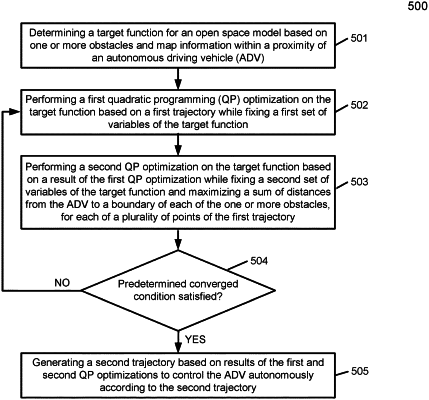| CPC G05D 1/0088 (2013.01) [G05D 1/0214 (2013.01); G05D 1/0221 (2013.01); G05D 2201/0213 (2013.01)] | 21 Claims |

|
1. A computer-implemented method for operating an autonomous driving vehicle, the method comprising:
determining a target function for an open space model based on two or more obstacles and map information within a proximity of an autonomous driving vehicle (ADV);
iteratively, until a predetermined converged condition is satisfied,
determining a first trajectory that initializes a first set of variables including dual variables that indicate a distance between each of the two or more obstacles and the ADV,
performing a first quadratic programming (QP) optimization on the target function based on the first trajectory while fixing the first set of variables of the target function, and
performing a second QP optimization on the target function based on a result of the first QP optimization while fixing a second set of variables of the target function, wherein second QP optimization includes maximizing a sum of distances from the ADV to a boundary of each obstacle in a set of two or more obstacles, over each of a plurality of points in time of the first trajectory, and wherein the target function includes a penalty for deviation based on the second QP optimization on the target function;
generating a second trajectory based on results of the first and the second QP optimizations; and
controlling the ADV autonomously according to the second trajectory.
|